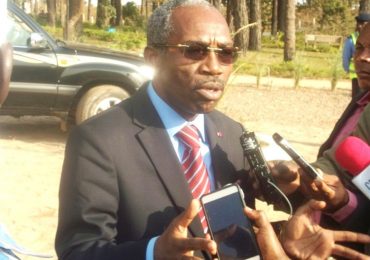The French company V. Mane Fils has signed the first-ever Mutually Agreed Terms (MAT) in Cameroon. This document embodies the legal requirement for the access and benefit sharing, resulting from the commercialization of the Echinops giganteus roots found in Magha-Bamumbu, Lebialem Division, Southwest Cameroon.
This agreement was facilitated by the Environment and Rural Development Foundation (ERuDeF) in collaboration with the ABS Capacity Development Initiative in Germany, under the supervision of the Ministry of the Environment, Nature protection and sustainable Development.
The MAT emanates from the Access Benefit Sharing principle (ABS), which advocates for the equitable distribution of benefits arising from the utilization of genetic resources of the Nagoya Protocol of 2010.
By Sheron Endah
On April 2, 2015, the people of Magha-Bamumbu and V. Mane Fils under the supervision of the Minister Delegate Dr. Nana Aboubakar of MINEPDED, met at the conference room of Ministry of Environment, Nature Protection and Sustainable Development with the purpose of signing the first MAT Document. The people of Magha Bamumbu was represented by HRM Lekunze A.N and Mr. Michel Mane Director General of V. Mane Fils under the watchful eyes of the Minster Delegate Dr Nana Aboubakar, in the presence of a range of stakeholders such as; The National ABS committee, ERuDeF, UNDP, GEF, COMIFAC, The French Embassy and the ABS Capacity Development Initiative Germany.
According to the MAT agreement, V. Mane Fils will export the Echinops roots while in return, the Bamumbu villagers will receive both monetary and non-monetary benefits to support their individual and community development projects, on the other hand non-monetary benefits will come through royalties, profits accruing from the sales of products made from the extracts of Echinops roots. Full of excitement the Minister Delegate said, “I encourage all traditional authorities to help in the realization of the process and I hope that this event will invite other companies to come to Cameroon”.
“It is a privilege that this is really happening in Cameroon and in Central Africa for the very first time. We hold this process so dear in mind as we will want communities to benefit from the exploitation of their natural resources,” said Galega Prudence, First Adviser to the Minister.
She also said it was for this reason that the Cameroon National ABS team met to carefully examine the draft MAT, making sure all the terms of the Nagoya Protocol were respected.
After the signing ceremony, the Fon of Bamumbu said his people remain hopeful that the MAT agreement will ameliorate their living conditions.
“We remain hopeful that the MAT is going to make the lives of the Magha-Bamumbu people better,” said Fon Lekunze Andreas.
As for Mane Michel, he said: “I come not to disrupt but to encourage conservation and sustainable use of Cameroon biodiversity….and the potential development of local communities through the development of value chains … he further declared that the Echinops giganteus root contains genetic elements with potential in the perfume industry, that can be used to manufacture flavors and fragrances”.
The process which started in 2012 in Magha-Bamumbu saw the guidance of ERuDeF and supervision from the government who made sure all the steps involved in the ABS process were strictly followed.
Prior to the signing of the MAT V. Mane Fils through its Foundation had already signed the Prior Informed Consent (PIC) with community in January 2013 and the research and Development with the Minister of Environment in May 2014.

Access and Benefit Sharing originates from the convention on Biological resources in 1992 stemming from the unequal distribution of biodiversity throughout the world. This is seen in the desire for technologically rich but biodiversity poor countries to have continuous access to these resources and secondly the concern of the biodiversity rich but technologically poor countries to benefit from the exploitation of their resources.
The NAGOYA Protocol on access to genetic resources of 2010 came as a response to the growing concerns of developing countries relating to the misappropriation of genetic resources and associated traditional knowledge and also the worries of users of genetic resources regarding the absence of clear procedures for obtaining access to genetic resources in a number of countries. This will then help to develop clear and transparent procedures for access to genetic resources and help ensure the sharing of benefits once genetic materials leave the provider.


